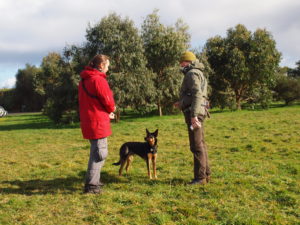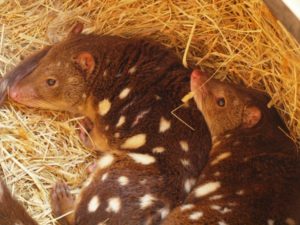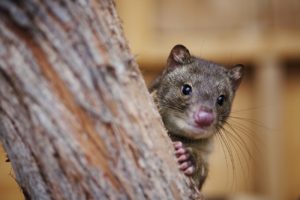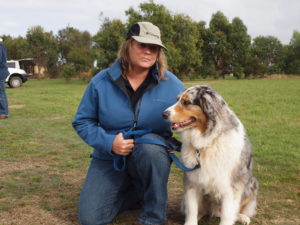Otways Conservation Dogs find evidence of endangered tiger quoll in Great Otway National Park
Ted is a member of the Otways Conservation Dogs, a team on a special mission to help protect the endangered Tiger Quoll from extinction. This week the former rescue dog made a very important discovery when he detected a wild quoll scat in the Cumberland Valley of the Great Otway National Park.
The Otways Conservation Dogs was initiated by the Conservation Ecology Centre after the organisation rediscovered Tiger Quolls in the Otways in 2012. The program involves a team of community volunteers working with their own dogs across a wide range of breeds, trained to work with minimal environmental impact to detect scats (droppings) of the endangered species. These scats have the potential to provide vital information to ecologists, significantly assisting conservation efforts.
Finding this evidence of tiger quolls presence is very challenging, however. Since the species’ rediscovery only four confirmations have been made and this evidence has been discovered far and wide across the region.
Conservation & Research Manager, Dr Jack Pascoe, said “The fact that the evidence collected over the last few years is so wide spread is encouraging as it suggests this is not just one or two individuals but a small population.
“However, sightings of quolls are rare, confirmed evidence is scarce and the species’ future is precarious. We need to gather data as quickly as possible to understand where quolls are surviving and how viable their population is. This information is crucial for effectively managing the Otways for their conservation.”
Parks Victoria Ranger Katrina Lovett said, “Parks Victoria needs good data to plan and manage for species preservation and habitat management in parks. Partnering with community organisations and citizen science volunteers can really assist in this. The Otways Conservation Dogs program is a truly inspiring example of partnership in action.”
Luke Edwards of Canidae Development has instructed the Otways Conservation Dogs since the program’s inception. He says “Dogs make an incredible contribution to our society; they can help us gather information in ways which we could never manage without them.
“Effective conservation detection dogs must have a wide range of skills – they must be fit enough to work long days in challenging environments, be confident to think and problem solve independently, and they need to be able to communicate effectively with their handlers. The dogs are highly trained and must pass rigorous assessments before they are deployed to work under Research Permits in the National Park.”
What is most surprising about this story is that its hero was once a lost dog. Found wandering the streets of Geelong in very poor condition in 2013, he was rescued by the Geelong Animal Welfare Society and then adopted into a new life at Cape Otway by Lizzie Corke and Shayne Neal, founders of the Conservation Ecology Centre. He was named Ted and since then has become a much loved member of the family and, clearly, an outstanding detection dog.
Jack Pascoe says “Ted loves his life and his job – he works tirelessly in difficult terrain and is absolutely dedicated to the search – he knows he has a very important job and our ecologists feel very privileged to work alongside him and the rest of the Otways Conservation Dogs teams.”
We’ll all be having a Prickly Moses Spotted Ale to celebrate!
Learn more about the Otways Conservation Dogs.
Learn more about the Endangered Species Surveillance Network Program.
This year, with your help, we rediscovered endangered Tiger Quolls in the Otways and initiated the Otways Conservation Dogs Project and Humane Fox Management Program. We have embarked upon an ambitious program, investigating and addressing koala habitat decline – an issue seriously threatening koalas in Victoria. You have also helped us to rescue and rehabilitate hundreds of injured and orphaned animals so that they can be returned to the wild.
Our supporters play an incredibly important role in the work of the CEC and we deeply value your involvement and commitment to wildlife conservation. Thanks to you, we have purchased a key piece of land at Cape Otway – the first stage in creating a vital wildlife corridor. It is a very special Christmas gift for the wildlife of the Great Ocean Road!
Spoil someone special with a Great Ocean Ecolodge Gift Voucher – order now. Perhaps a piece of handmade jewellery to support Tiger Quoll conservation? See the range and place an order here. These gifts are great under the tree or can be posted easily – Gift Vouchers can even be sent electronically for super Christmas speed. Because all profits go directly to support CEC conservation programs you will be giving a gift to the wildlife at the same time!

Can you see Father Christmas yet?
Thank you for sharing 2012 with us. Warmest wishes for the festive season and a fabulous New Year!
Learn more about the Tiger Quoll Conservation Program and Otways Conservation Dogs
Learn more about the Koala Conservation Program
Learn more about Manna Gum Reserve
Support Australian wildlife this Christmas – make a donation
 We are delighted to announce the arrival of four beautiful, endangered Tiger Quoll joeys. The gorgeous spotted joeys are now three months old and fit into the palm of your hand.
We are delighted to announce the arrival of four beautiful, endangered Tiger Quoll joeys. The gorgeous spotted joeys are now three months old and fit into the palm of your hand.
Lizzie Corke, CEO of the Conservation Ecology Centre, says raising this many joeys in a first breeding season is unusual but the joeys are all healthy and their mother is caring for them beautifully. “They are growing fast and keeping snug and warm in the den,” she says. The joeys will help inform researchers about Tiger Quoll behaviour and assist with the conservation of these endangered animals. “These little quolls are helping to conserve their species” says Conservation Coordinator Dr Jack Pascoe.
Tiger Quolls are the largest remaining marsupial predators on the Australian mainland but their numbers are in serious decline. “By learning more about their behaviour we can improve detection techniques, which will play a vital role in the conservation of wild Tiger Quolls and the ecosystems they depend upon,” Dr Pascoe says.
Dr Pascoe says a captive breeding population is an important insurance policy for endangered species and, in time, these joeys will contribute to the long-term health of the captive population.
Wild Tiger Quolls were thought to have died out in the Otways for nearly 10 years until the recent discovery of scat (droppings) near Lorne and Cape Otway, which Ms Corke says has been an exciting and encouraging development.
The Conservation Ecology Centre is working on a number of projects to safeguard the future of Tiger Quolls, including training a team of community volunteers and their dogs to detect Tiger Quoll scats. Habitat restoration and fox reduction projects are also key activities of the program. You can get involved in this exciting project too! Make a donation to ensure the future of this special species, see our Conservation Experiences for voluntourism opportunities or become a volunteer.
Why is there a need for Conservation Dogs in the Otways?
The Tiger Quoll is the largest remaining carnivorous marsupial on the Australian mainland. It is an endangered species and is declining across its entire range, even in the Otways which was once a key habitat for the Tiger Quoll.
One great way for detecting an elusive animal while causing minimal impact is through finding scats (poos). Scats contain DNA fragments and these can be extracted and analysed to gain insights into the population through a better understanding of their genetics.
Until 2012 there was no confirmed evidence of Tiger Quoll presence in this region for nearly a decade. This year the Conservation Ecology Centre discovered scats of two different Tiger Quolls in different areas of the Otways. Both these scats were discovered by chance and you can read more about each discovery here. Dogs have highly sensitive noses and can be trained to find a target scent – through teaming up with man’s best friend we can greatly increase the efficiency and effectiveness of our detection efforts.
Who are the Otways Conservation Dogs?
The project is led by the Conservation Ecology Centre, working in collaboration with Canidae Development* and the 2012 program has been proudly supported by the Mazda Foundation.
The team is comprised of canine volunteers from our community and their people – an incredible group who are working together, learning from one another and contributing to the conservation of the region.
How do you make sure the Quolls are not affected by the dogs?
We are working in very environmentally sensitive areas and are careful to minimise the impacts of our activities. Otways Conservation Dogs are trained to find the evidence of Tiger Quolls not the animal itself; in this case we are searching for Tiger Quoll scat (poo). Our training is about detection and the dogs are trained to perform a passive alert behaviour of dropping (or sitting for the very little dogs in the team!) on locating a scat sample. There is absolutely no barking, scratching or digging and the dogs do not interact directly with the scent source.
Highly trained dogs and handlers are assessed according to strict criteria for operational readiness. When dogs are operational they are deployed according to protocols under the direction and supervision of a Conservation Ecology Centre representative.
Otways Conservation Dogs are taught not to be distracted by other animals as part of their training – our dogs are not allowed to chase any animal at any time (this includes wildlife, domestic and pest species). In fact, our dogs are so well trained around wildlife that the wild kangaroo mob often hangs around on a Sunday morning to watch our training sessions!
What sorts of dogs make good detection dogs?
 Our team comprises a wide range of dog breeds and personalities – from gutsy Jack Russels and happy Bishon Frise to eager German Shepherds, conscientious Australian Shepherds, delightful Golden Retreivers, smiley Spaniels, focused Kelpies and bouncy Border Collies – to name a few!
Our team comprises a wide range of dog breeds and personalities – from gutsy Jack Russels and happy Bishon Frise to eager German Shepherds, conscientious Australian Shepherds, delightful Golden Retreivers, smiley Spaniels, focused Kelpies and bouncy Border Collies – to name a few!
Our skilled instructor from South West Victorian Dogs brings out the very best in each dog/handler team, working together with everyone to find the training approach which best suits each combination. We have seen incredible advancements in every single member of the team – both human and canine.
Our team members live both locally and quite far away, with some members rising at 4am to make our Sunday morning training sessions.
How can I get involved?
The project is currently running at capacity, however, if you are interested in getting involved we welcome you to get in touch via our contact form and we can discuss the opportunities for the future. There are certainly ways to get involved with this project even if you don’t have a dog!
 Learn more about Tiger Quolls.
Learn more about Tiger Quolls.
Learn more about the Tiger Quoll Conservation Program.
Read up on the Conservation Ecology Centre’s 2012 discoveries of Tiger Quolls in the Otways – the Eastern Otways scat and the Cape Otway scat.
Learn more about the Otways Conservation Dogs Project.
*We began working on this project with South West Victorian Dogs but Luke Edward’s work has quickly outgrown the scope of the SWVD organisational structure. Canidae Development was launched in July 2013 and we are delighted to have been able to witness this evolution – it is an exciting time for dogs in conservation.
Local Parks Victoria Ranger, Nick Alexeyeff, collected a scat in the National Park, not far from the CEC property. He handed it in to us for DNA testing by cesar and it has been confirmed as Tiger Quoll – making it the second confirmed piece of evidence of quolls in the region in a month! After nearly a decade it is wonderful to know that there are a few quolls still hanging on in the wilds of the Otways. It makes our conservation work even more vital. The DNA from this scat will be compared with the first to gain some preliminary insights into the genetic diversity of the population.
This is the Media Release from Parks Victoria. Issued 28th May 2012
Parks Victoria has received confirmation that a scat (that’s poo to most of us) found by Ranger Nick Alexeyeff in the Great Otway National Park is that of the rare Spot-tailed Quoll (Dasyurus maculatus), also known as a Tiger Quoll.
It is another piece of evidence that Spot-tailed Quolls are still living in the park.
Nick Alexeyeff collected the scat in the Cape Otway area. “I was walking through quite thick bush in the park with some contractors looking at options for a realignment of the Great Ocean Walk.
 “There was a big fallen tree in our path covered in moss, and a scat right on top. I took a closer look and noticed fine filaments of fur which told me it came from a predator and could be a quoll.
“There was a big fallen tree in our path covered in moss, and a scat right on top. I took a closer look and noticed fine filaments of fur which told me it came from a predator and could be a quoll.
“It was almost as if this big tree was like a highway running through the scrub and a regular track taken by the animal,” said Nick.
“I emptied my lunch box, popped in the scat and took it to the Conservation Ecology Centre who arranged to have it DNA tested, and we have now received confirmation it is a quoll.”
The scat was confirmed as that of a Spot-tailed (Tiger) Quoll after a rigorous DNA analysis by Dr Andrew Weeks at cesar, a research centre specialising in genetic analysis for wildlife conservation in Melbourne.
“Scats contain DNA from the source animal, so we can determine the species which left the scat using species specific DNA markers,” Dr Weeks explained. Cesar will now undertake further testing to better understand the origins of the animal.
The Quoll is a predator at the top end of the food chain. It is the largest carnivorous marsupial remaining on mainland Australia, so is not found in high numbers, but this evidence is the first in 13 years that quolls are active in the park.
The Conservation Ecology Centre’s CEO, Lizzie Corke, explains that these animals are already endangered, and although the Otways has traditionally been a stronghold for the species, there has been a dramatic decline in numbers.
“Introduced predators such as foxes and cats have combined with habitat destruction and fragmentation of populations such that the species is now critically in danger of extinction in this region.”
Jack Dinkgreve, Parks Victoria Ranger in Charge for the East Otways added that the scat was found in an area where a
fox control program has been operating for several years.
“We have been working on fox control continuously for three or four years now and we believe that may well have made a difference. Removing foxes and other pests like wild cats give animals like the quoll a much better chance of surviving and thriving,” he said.
Because of their large home ranges and their position at the top of the food chain, efforts made to conserve the Tiger Quoll benefit a wide range of other species which depend on the habitats of the Otways.
To understand more about the Tiger Quoll, Parks Victoria, the Department of Sustainability and Environment, and the Conservation Ecology Centre (CEC) are surveying for them using established techniques such as remote sensor cameras. The CEC is also developing a team of detection dogs, trained to search out Tiger Quoll scats.
“This discovery has created a fair amount of excitement in our office, it means that the park is doing its job, protecting our native wildlife for the future,” Jack Dinkgreve added.
Listen to the interview on ABC Radio National.
 Holidaymakers in the Otways have unknowingly collected the first evidence of endangered Tiger Quolls in the Otways for almost a decade. The scat has just been confirmed as that of a Tiger Quoll through DNA analysis by Dr Andrew Weeks at cesar, a research centre specialising in genetic analysis for wildlife conservation in Melbourne.
Holidaymakers in the Otways have unknowingly collected the first evidence of endangered Tiger Quolls in the Otways for almost a decade. The scat has just been confirmed as that of a Tiger Quoll through DNA analysis by Dr Andrew Weeks at cesar, a research centre specialising in genetic analysis for wildlife conservation in Melbourne.
Tiger Quolls are the largest marsupial carnivores remaining on the Australian mainland, and, as an apex predator, living at the top of the food chain, the species plays an important role in the ecosystem.
Already endangered, Tiger Quoll populations are declining across their entire range. Although the Otways has traditionally been a stronghold for the species, introduced predators such as foxes and cats have
combined with habitat destruction and fragmentation of populations resulting in dramatic declines over the last several decades and the species is now critically in danger of extinction in this region.
The great news unfolded recently when holidaymakers went to check a heavy thump on their back deck, and found a ‘spotted, ginger’ animal ‘a bit like a big possum’. The animal, which reminded the observers of a Tassie Devil, nonchalantly wandered across the deck, then stopped to drop a scat before jumping off.
Luckily the holidaymakers had the foresight to collect the scat and popped into the local Visitor Information Centre to ask about what they might have seen. The staff there gave them the contact details for the Conservation Ecology Centre (CEC) at Cape Otway.
With the support of their Patron, the Hon. Steve Bracks AC, the CEC is working to conserve Tiger Quolls across the Otways, working with government land management agencies and private landholders.
The Centre’s Co-Founder and CEO, Lizzie Corke, explains why these animals are a top priority for the Centre:
“Healthy and robust ecosystems are vital for the survival of us all and every species lost further jeopardises the ability of these ecosystems to bounce back. Because of their large home ranges and their position at the top of the food chain, efforts made to conserve the Tiger Quoll benefit a wide range of other species which depend on the habitats of the Otways. So much has been lost already that we need to make an urgent and concerted effort to care for what we have left.”
Acting Senior Biodiversity Officer at The Department of Sustainability and Environment, Saul Vermeeren, discusses the Otways quoll population:
“We don’t know how many quolls we still have living in the wilds of the Otways, or if they still constitute a genetically viable population. The confirmation that Quolls still exist in the region gives us the power to make informed planning
decisions on the management of public land. Hopefully by undertaking more intensive surveys and considering appropriate land management practices we will be able to generate positive outcomes for the species that will allow it to flourish in the wild.”
To understand more about the Tiger Quoll, DSE, Parks Victoria and the Conservation Ecology Centre are surveying for them using established techniques such as remote sensor cameras. The CEC is also developing a team of detection dogs, trained to search out Tiger Quoll scats. Tiger Quoll scats are then confirmed through DNA analyses.
“Scats contain DNA from the source animal, and we can therefore determine the species which left the scat using species specific DNA markers” Dr Andrew Weeks explains.
A key threat to Tiger Quolls is invasive predators, particularly foxes, and efforts to decrease fox numbers are vital for ensuring the future of Tiger Quolls in the Otways.
If you have seen a Tiger Quoll or are interested in getting involved with the program as a volunteer contact us.
… you might not see a Tiger Quoll. However, that doesn’t mean that they are not there.
In an innovative move from the Conservation Ecology Centre, Cape Otway, this week saw the first training session for a team of canine volunteers – and their owners. Their mission? To help the Centre protect endangered Tiger Quolls from extinction.
Thanks to a grant from the Mazda Foundation, the Conservation Ecology Centre has teamed with South West Victorian Dogs to develop the program. And with 15 dogs of all breeds, colours and sizes already on board, Otways Conservation Dogs are off to a great start.

First training session of the Otways Conservation Dogs - March 2012
Though once common throughout the Otway Ranges, Tiger Quolls – the largest marsupial predators surviving on the Australian mainland – have become increasingly rare across their entire range and are now in critical danger of extinction in this region.
Lizzie Corke, CEO of the Centre explained the importance of the program:
“Every species is connected to other species in an ecosystem, so by working to conserve Tiger Quolls we benefit all the indigenous species in a region.”
“While sightings of Tiger Quolls are frequently reported there has been no confirmed evidence of their existence for nearly a decade. Although they are shy and nocturnal, Tiger Quolls have one habit which may help us in finding them … they all poo in the same place. So, if we can find those places (communal latrine sites) we can collect their poo and carry out DNA analysis to identify each individual Tiger Quoll living in the Otways and gain important insights into their status and location.”
However, the Otways is a big place to go looking for small piles of poo and finding them requires an innovative response. This is where the Otways Conservation Dogs come in.

Otways Conservation Dogs Instructor, Luke Edwards from South West Victorian Dogs, training Delta the detection dog in the forests of Cape Otway
On Sunday 18th March 2012 the first training session took place at the Conservation Ecology Centre in Cape Otway. Experienced search and rescue dog handler and instructor, Luke Edwards of South West Victorian Dogs, said:
“This is an exciting beginning. It is the first time a team of community volunteers is training to detect endangered species, so we are charting new territory!
Barking is often used as an alert in detection work, however, in this project we are training the dogs to use ‘passive alerts’, dropping and staying to signal a find. This will minimise the dogs’ impact on wildlife in the environmentally sensitive areas in which we will be working.”
“We have dogs at all stages and they all worked really well today – they are still much loved family pets but will also be assets in wildlife conservation.”

Cheryl Nagel volunteers as an Otways Conservation Dogs member with her Australian Shepherd, Zeke
Cheryl Nagel volunteers with her dog, Australian Shepherd, Zeke.
Cheryl explained “I really enjoy spending time with my dog and being in the bush. I am very concerned about plight of the Tiger Quoll and wildlife conservation in general, and getting involved in Otways Conservation Dogs is great way to make a useful contribution.”
Other projects in the Centre’s Tiger Quoll Conservation Program include remote camera surveys, feral predator control, small mammal conservation and habitat restoration and reconnection.
So keep an eye open for these feisty little creatures. And if you would like to help, then contact the Conservation Ecology Centre.
Update 2013: The OCD project continues in leaps and bounds – find out all the latest details on the Otways Conservation Dogs.



